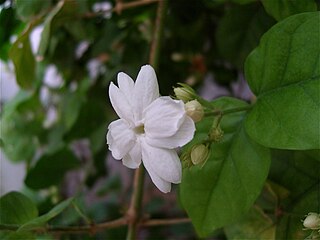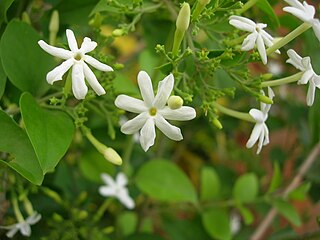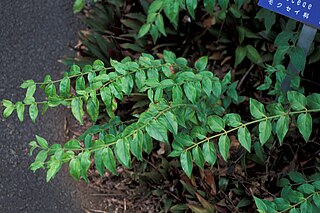
Jasmine is a genus of shrubs and vines in the olive family of Oleaceae. It contains around 200 species native to tropical and warm temperate regions of Eurasia, Africa, and Oceania. Jasmines are widely cultivated for the characteristic fragrance of their flowers.

Nyctanthes arbor-tristis is a species of Nyctanthes native to South Asia and Southeast Asia. It is commonly known as night-blooming jasmine, tree of sadness, tree of sorrow, hengra bubar, coral jasmine, as seri gading in Singapore and as shiuli in the Bengal region. Despite its common name, the species is not a "true jasmine" and not of the genus Jasminum.
Jasmine is a flowering shrub of the genus Jasminum. It may also refer to:

Jasminum sambac is a species of jasmine with a native range from Bhutan to India It is cultivated in many places, especially West Asia, South Asia and Southeast Asia. It is naturalised in many scattered locales: Mauritius, Madagascar, the Maldives, Christmas Island, Chiapas, Central America, southern Florida, the Bahamas, Cuba, Hispaniola, Jamaica, Puerto Rico, and the Lesser Antilles.
Hoovina Hadagali or Huvina Hadagali is a town and a taluk in the Vijayanagara district of Karnataka, India. It is the administrative headquarters of the HuvinaHadagali Taluk.

Jasminium dichotomum, the Gold Coast jasmine, is a species of jasmine, in the family Oleaceae. It is an evergreen climber which grows as a rambling shrub or woody vine. The flowers are quite fragrant and open at night, coloured pink when budding then white; these appear at the leaf axils in cluster. It blooms year round. The leaves are opposite. The fleshy fruit is small.

Jasminum grandiflorum, also known variously as the Spanish jasmine, Royal jasmine, Catalan jasmine, Sicilian jasmine, is a species of jasmine native to South Asia, the Arabian peninsula, East and Northeast Africa and the Yunnan and Sichuan regions of China. The species is widely cultivated and is reportedly naturalized in Guinea, the Maldive Islands, Mauritius, Réunion, Java, the Cook Islands, Chiapas, Central America, and the Caribbean. It is closely related to, and sometimes treated as merely a form of, Jasminum officinale.

Jasminum parkeri, the dwarf jasmine, is a species of plant in the family Oleaceae. It is a domed evergreen shrub, growing to about one foot in height, which bears a muddled bunch of small stems with tiny oval leaves. Teeming clusters of fragrant, tiny 5-lobed, yellow tubular flowers, from the axils of the leaves in early summer. Dwarf jasmine is a container plant or trained around topiary form.

Jasmine is considered the queen of flowers and is called the "Belle of India" or the "Queen of fragrance" as it is exquisitely scented to soothe and refresh. In different parts of India it is called by different names—Mogra, Motia, Chameli, Malli puvvu, Jaati, Mulla, Mallige, Juhi, Mogra or Moonlight in the grove. It is reported that there are 300 varieties of jasmine. It is also stated that jasmine crossed the seas—from Asia to Europe, landing first along the Mediterranean Sea, conquering Greece and Turkey, reaching Western Europe through Spain, then France and Italy and finally landing in England in the latter part of the 17th century..

Jasminum officinale, known as the common jasmine or simply jasmine, is a species of flowering plant in the olive family Oleaceae. It is native to the Caucasus and parts of Asia, also widely naturalized.

Jasminium abyssinicum is a species of jasmine, in the family Oleaceae.

Jasminum multiflorum, commonly known as star jasmine, is a species of jasmine in the family Oleaceae.

Jasminum multipartitum, the starry wild jasmine, African jasmine, or imfohlafohlane, is a species of jasmine, in the family Oleaceae, that is native to Southern Africa.

Jasminum didymum is a species of scrambling vine or low shrub. It is native to insular Southeast Asia from Java to the Philippines, as well as Australia, as well as some islands in the Pacific. Jasminum didymum occurs naturally in habitats from rainforests to arid and semi-arid shrublands.

Chrysojasminum humile, the Italian jasmine or yellow jasmine, is a species of flowering plant in the family Oleaceae, native to Afghanistan, Tajikistan, Pakistan, Nepal, Burma (Myanmar), the Himalayas and south west China. The species is widely cultivated and reportedly naturalized in Greece, Sicily and the former Yugoslavia.

Jasminum tortuosum is a species of jasmine native to South Africa. It is generally found twining high into the trees of forests in southwestern part of Cape Province, but also may scramble where there is little vertical space. It has angular branches off its main stem, and its flowers usually have five white petals each. The specific epithet (tortuosum) is from Latin, describing something that is winding or very twisted.

Jasminum malabaricum, the Malabar jasmine or wild jasmine, is a species of flowering plant in the family Oleaceae, native to southern parts of India, and Sri Lanka.

Jasminum angustifolium, the wild jasmine, is a species of jasmine native to Sri Lanka and India, including the Andaman Islands. It is a climbing shrub with a smooth stem and minutely pubescent branchlets. It grows up to 6 m (20 ft) tall. Leaves are dark green and opposite in arrangement. The flowers are approximately 25 mm (1 in) in diameter, and resemble a star with seven or eight narrow petals, flowering between June and August.
Needle flower or Needle-flower may refer to various plants, including:


















